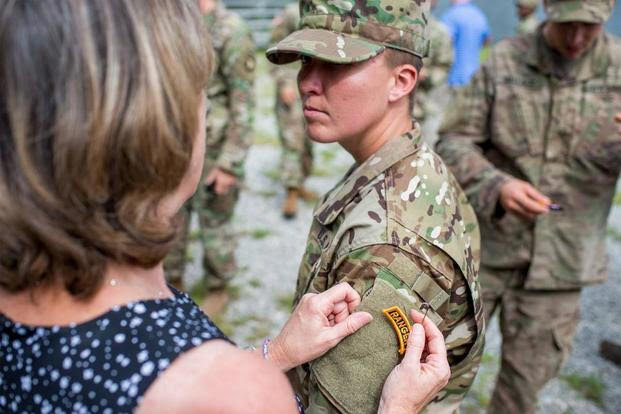The Army Infantry Doesn’t Just Need More Women. It Needs More Qualified Women.
6 min read
Capt. Shaina N. Coss was among the first 10 women to graduate from Ranger School and became the first female infantry officer to serve in the 75th Ranger Regiment in 2018. She is currently serving on active duty at the U.S. Marine Corps Expeditionary Warfare School in Quantico, Va.
Recent attention surrounding the Army Combat Fitness Test, or ACFT, produced a scornful public response shaming the Army into lowering physical standards to accommodate the more than 50% of women who failed to meet the minimum requirements during initial testing.
Resulting backlash encouraged the service to suspend its stratified, color-coded grading system, which had required the highest fitness standards for combat arms (black) and high standards for jobs like Military Police (gray). Both standards were replaced with a lower minimum (gold) for all soldiers regardless of military occupational specialty, or MOS, in the ACFT 3.0 version.
While the Army has yet to announce whether it will reinstate tiered fitness standards, some continue to argue that the service must permanently allow substitutions for the leg tuck as they believe it discriminates against women, who lack the upper-body strength of men.
Removing high standards and offering substitutions like the plank pose will increase pass rates among women, leading the Army to falsely conclude that it has achieved gender equality. However, this will not lead to the true advancement of women. While convenient for the current failures, this shortsighted reaction is ultimately degrading to all women, disproportionately harmful to the women in the infantry, and illogical.
As the first and only female infantry officer to serve in the 75th Ranger Regiment to date, I know that equality will be achieved only when women are held to the same job-related standards. A meaningful way to do this is to immediately reinstate the black and gray tiered fitness standards.
I know that equality will be achieved only when women are held to the same job-related standards.
Permanently allowing soldiers who are not on a medical profile to complete an alternate event tacitly endorses the false notion that those soldiers (who are mostly women, in this case) are incapable of improving themselves. This is not only insulting, it is wrong. It sends the misguided message that women should not be held responsible for their actions, or rather their lack of physical preparation. Establishing this double standard contributes to the already pervasive sentiment that women are incapable and inferior. This will not only be detrimental to female advancement by undermining our authority to lead men who are held to a higher standard, but it also dishonors the Army.
I recognize that high fitness standards are not the only way to earn credibility, but a leader who achieves low fitness standards inspires little confidence, especially in the Army’s most physically demanding branch — the infantry. For an organization that purportedly seeks to empower women, it is disgraceful that the Army would consider lowering standards to increase pass rates at the expense of diminishing the credibility of women to lead soldiers, particularly infantrymen.
The six events of the ACFT were chosen because they correlate to commonly occurring physical skills from the Warrior Tasks and Battle Drills, or WTBD, and Common Soldier Tasks, or CST. By choosing exercises that correlate to success in the WTBD/CST, the Army can theoretically predict success in combat. When performed together, the events have a greater than 80% correlation to the WTBD or CST. The old Army Physical Fitness Test had just over a 40% correlation.
Because the combat requirements of each MOS are not the same, tiered fitness standards allow for calibrated physical performance relative to occupational skills. ACFT results give leaders a better indication of a soldier’s potential performance than a gender- and age-normed scale that can mask physical readiness. Removing the tiered black fitness standard may bolster pass rates in the short term, but it will likely jeopardize the future accomplishments of infantrymen in the crucible of ground combat and stymie the acceptance of women within the branch.
“With Equal Opportunity Comes Equal Responsibility.”
Moreover, it simply does not follow that because women may initially lack upper body strength that they are incapable of successfully passing physical standards with sufficient training. I have personal experience in this matter because I — like numerous women — failed my first diagnostic ACFT. I was humiliated and disappointed when I failed the standing power throw, but I was also determined to improve, much like Capt. Kristen Griest, who details her experience in her recent article “With Equal Opportunity Comes Equal Responsibility.”
In response, I added the standing power throw to the warm-up of all of my workouts by purchasing my own 10-pound medicine ball. I soon increased my score to over 8 meters, and I am confident that healthy women who face similar challenges with the leg tuck are equally capable of overcoming their weakness with adequate training. Meeting the same standard as the men I lead makes me eager to improve even more. I recognize that hard work and grit are the only ways to truly diminish the gap between men and women.
Further, it is irrational for the Army to expect that lower fitness standards will improve the equality of female soldiers because men and women are biologically very different and because effort is an individual choice.
There are countless physiological handicaps that make physical success more difficult for women to achieve relative to their male counterparts. For example, when compared to a man of equal height, a woman will naturally have less muscle, more fat, less testosterone, less iron, smaller lungs and a smaller heart. These conditions yield a decreased natural aptitude for combat fitness.
In order to achieve closer ACFT scores between the genders, women need to cultivate self-awareness to recognize their disadvantage and put in more effort than their male peers. The Army — or for purposes of this argument, the ACFT — is not sexist because of this fact. Alternatively, the ACFT is empowering as it has led (and will continue to lead) women to devote more effort, seek out more mentorship, and train harder than they would have otherwise.
Finally, lowering standards is illogical because true equality comes from real achievement, not from the Army adjusting numbers to generate more favorable scores. Although equal pass rates across the service are desirable, discrepancies between the scores of men and women are inevitable. This does not mean that the standards for the combat-arms branches should be lowered. Conversely, high fitness requirements will improve the standing of women in combat arms because they demonstrate that they have earned the right to serve in the unit by achieving the same high standard as men. Instead of halting implementation, women simply need to train harder to pass this test.
Before implementation, the Army was clear about its elevated fitness requirements for the infantry; it would be antithetical for it to renege on those standards. As one of the first 10 women who earned the privilege to wear the blue cord of the infantry and the coveted Ranger tab, I recognize the enduring need to work hard. All women, especially female infantrymen should adopt a similar mindset.
Ultimately, this is not only a discussion around gender standards, but around the uncompromising standards of armed conflict. Anyone desiring to serve this country needs to meet the standard, rather than lobbying for exceptions based on gender. Lowering physical requirements may ostensibly lead to the short-term “equality” of women; however, any advancement because of gender and not merit is corrupting to this vital organization. Rather than lowering the bar to accommodate the inability of a few, raise the bar and inspire leaders to achieve more.
We, the women of the infantry, want more qualified women to join our ranks. We do not simply want more women.
We, the women of the infantry, want more qualified women to join our ranks. We do not simply want more women.





